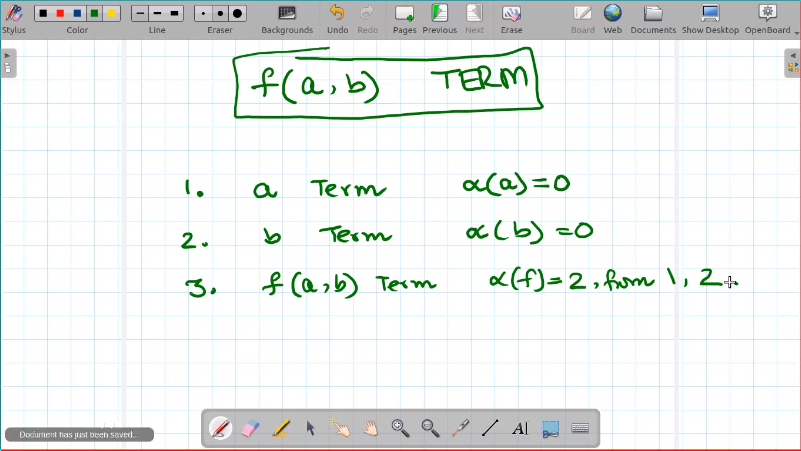PoPL Lecture 6
Agenda: Syntax (Co-inductive Terms)
- Last time, we had terms, defined in terms of induction and expression:
- Defining a base case for an expression
- Inductively, defining the set of all expressions
- This was done for an operation
- Example from last class
|--------------------| | | if n ∈ N | num rule | | ⇒ n AST | | Defines all | OR | > expressions | if e1 AST & e2 AST | plus rule | in addition | ⇒ + e1 e2 AST | | |--------------------| |
- This time, we will focus on Structural Induction: on trees, instead of $n$
Generalising induction
- We want to define terms inductively. Inductive terms
- We assume an alphabet $\Sigma$ of constructor symbols
- What are constructor symbols? Kind of like functions that operate on some terms (arity, as we shall find out) and return terms as results. Think of the ‘+’ operator.
- Eg: $\Sigma = {f, g, a, b}$
- We define an “arity” function that operates on $\alpha : \Sigma \to N$ (Natural numbers)
- Arity defines how many parameters the operator can take.
- Eg: $\alpha (f) = 2, \alpha (g) = 1, \alpha (a) = \alpha (b) = 0$
- So, terms can be built like:
f(a(), b()) \_ inductively building terms f(g(a), b) / - So, to define inductive terms: Given a constructor symbol f with arity α(f) = n and n terms, f(the n terms) = a new term
t₁ ... n terms and α(f) = n \ ---------------------------- > constructor rule ⇒ f(t₁ ... n terms) is a term / -
Can be used to make judgements on terms (slide below)

- wordy definition of this:
- if $t_1 … t_n$ Terms
- and $f \in \Sigma$ s.t. $\alpha(f) = n$
- then $f(t_1 … t_n)$ is a term
-
The set of all Inductive terms over $\Sigma \implies T_{ind}(\Sigma)$ is the smallest set satisfying the above properties:
So Tᵢₙ∑ would have: a, b, f a b, g a, g b, f g a b, f a g b, g f a b, f g f a b a, etc -
Why bother with a boring induction based proof? We will move on to eventually define evaluation itself as an induction system, not just terms.

- What is a set $X = \Sigma(X)$. We need the least solution, as there are many.
$T_{ind}$ is the least solution.
Saying that this is the least solution and giving the definition of it is identical.
- Is it possible to have ‘infinite’ terms?
We have Can we have
+ g
/ \ /
a b g' or g<-\
/ |__|
g''
- Any proof is a finite structure
- The set itself is infinite
- But every element in the set if finitely constructed
- $T_{ind} = \Sigma(T_{ind}) \subset T_{ind}$
- Testing a $\sum$ operator
- Hey ~a\ cat~
- [This is in small caps]{.smallcaps}